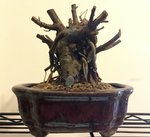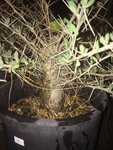You are using an out of date browser. It may not display this or other websites correctly.
You should upgrade or use an alternative browser.
You should upgrade or use an alternative browser.
The odd species for bonsai thread
- Thread starter leatherback
- Start date
ABCarve
Masterpiece
AlainK
Imperial Masterpiece
Plectranthus
... looks particularly spectacular when flowerless.
Woocash
Omono
That lavender/pot combo is something to behold.
Joe Dupre'
Masterpiece
Mike Hennigan
Chumono
AlainK
Imperial Masterpiece
Beautiful little guy.
I suppose it's quite small : it could be an outstanding companion plant for a large bonsai, or for a "mutiple shohin" display.
What's its size ?... (19 cm ?)
Great (small) tree. Five stars :




I suppose it's quite small : it could be an outstanding companion plant for a large bonsai, or for a "mutiple shohin" display.
What's its size ?... (19 cm ?)
Great (small) tree. Five stars :
Mike Hennigan
Chumono
Yea I’ve thought the same thing... could totally work as a companion plant. Can’t give you cm exactly right now (at work). But here’s a pic of it earlier in the summer with my hand for scale. It looks fantastic right now, leaves have filled out a bit better and it’s got some fall color. Will have to snap a pic when I get home. But yea... pretty small.




AlainK
Imperial Masterpiece
Best tree of the week ! 
So cool, congratulations.
Since the distance between the tip of the thumb and the little pinky is about 20 cm, it's an old unit of measurement : "un empan".
It gave the word "span" in English :
"The span of something that extends or is spread out sideways is the total width of it from one end to the other.
It is a very pretty butterfly, with a 2 inch wing span.
The hip joint is a hand span below the waist." (collinsdictionary.com)
You in the USA that still count in feet, Farenheit, gallons and other medieval units, do you have a word for "empan" ? I often use it to measure things roughfly.

It's OK for the garden, or having an overall idea of what you need but right now I'm refurbishing a room, and decimal units, metres, cm and millimetres are much easier, and so much more precise to use.
That's probably why scientists use them instead of the medieval, colonial units in the USA
Sorry, couldn't help it, just poking fun at you once again, no harm intended, huh, huh...
So cool, congratulations.
Since the distance between the tip of the thumb and the little pinky is about 20 cm, it's an old unit of measurement : "un empan".
It gave the word "span" in English :
"The span of something that extends or is spread out sideways is the total width of it from one end to the other.
It is a very pretty butterfly, with a 2 inch wing span.
The hip joint is a hand span below the waist." (collinsdictionary.com)
You in the USA that still count in feet, Farenheit, gallons and other medieval units, do you have a word for "empan" ? I often use it to measure things roughfly.

It's OK for the garden, or having an overall idea of what you need but right now I'm refurbishing a room, and decimal units, metres, cm and millimetres are much easier, and so much more precise to use.
That's probably why scientists use them instead of the medieval, colonial units in the USA
Sorry, couldn't help it, just poking fun at you once again, no harm intended, huh, huh...
Mike Hennigan
Chumono
Best tree of the week !
So cool, congratulations.
Since the distance between the tip of the thumb and the little pinky is about 20 cm, it's an old unit of measurement : "un empan".
It gave the word "span" in English :
"The span of something that extends or is spread out sideways is the total width of it from one end to the other.
It is a very pretty butterfly, with a 2 inch wing span.
The hip joint is a hand span below the waist." (collinsdictionary.com)
You in the USA that still count in feet, Farenheit, gallons and other medieval units, do you have a word for "empan" ? I often use it to measure things roughfly.
View attachment 267976
It's OK for the garden, or having an overall idea of what you need but right now I'm refurbishing a room, and decimal units, metres, cm and millimetres are much easier, and so much more precise to use.
That's probably why scientists use them instead of the medieval, colonial units in the USA
Sorry, couldn't help it, just poking fun at you once again, no harm intended, huh, huh...
Oh haha no worrries I’m on the same page. I majored in a science in college. I much prefer to measure things in the metric system. I’m probably the exception though. Thanks for the compliments on the tree.
Atom#28
Chumono
Since the distance between the tip of the thumb and the little pinky is about 20 cm, it's an old unit of measurement : "un empan".
MIND BLOWN. I just checked, my empan is exactly 20 cm. WHY DIDN'T I KNOW THIS?!
I learn something new every time I log in to this forum
Hack Yeah!
Omono
Bonsaidoorguy
Chumono
I'm in the states and have worked in woodworking all my working life. So I've only known our archaic system of measurement. I machine doors for high end residential and commercial application, and when the customer wants some European hardware it's always a pain in the ass. Not just because of the measurements, but the usual complicated over engineering that is usually involved.Best tree of the week !
So cool, congratulations.
Since the distance between the tip of the thumb and the little pinky is about 20 cm, it's an old unit of measurement : "un empan".
It gave the word "span" in English :
"The span of something that extends or is spread out sideways is the total width of it from one end to the other.
It is a very pretty butterfly, with a 2 inch wing span.
The hip joint is a hand span below the waist." (collinsdictionary.com)
You in the USA that still count in feet, Farenheit, gallons and other medieval units, do you have a word for "empan" ? I often use it to measure things roughfly.
View attachment 267976
It's OK for the garden, or having an overall idea of what you need but right now I'm refurbishing a room, and decimal units, metres, cm and millimetres are much easier, and so much more precise to use.
That's probably why scientists use them instead of the medieval, colonial units in the USA
Sorry, couldn't help it, just poking fun at you once again, no harm intended, huh, huh...
canoeguide
Chumono
Spiraea japonica ‘goldmound’. Common landscape shrub, uncommon bonsai. First picture is just after potting into a bonsai pot, second picture is two year later.
Spirea is on my list of things I'm dying to try working with, but so far I can't find anything larger than a pencil. I have some that have been in ground as landscape plants at my house for at least 8 years, but they do not have any girth to them at all. Twiggy mounds of sticks, they are. Any advice on where to find spirea with at least the start of a trunk?
Mike Hennigan
Chumono
Spirea is on my list of things I'm dying to try working with, but so far I can't find anything larger than a pencil. I have some that have been in ground as landscape plants at my house for at least 8 years, but they do not have any girth to them at all. Twiggy mounds of sticks, they are. Any advice on where to find spirea with at least the start of a trunk?
So it’s hard to tell from the photo, even in person. But the main trunk is actually a big fat exposed root... seemingly. There are lot of exposed roots like aerial roots on a ficus as well on the sides and a lot more on the back. I bought this one from a garden center about three years ago. I bought it because I saw the “trunk” root was partially exposed. And when I repotted it I happily found another inch or so of trunk. It was not something I had ever seen before on spiraea. But I have to assume that there are a lot more out there with a fat trunk like root underneath the soil. The only way to find out is pretty invasive but might be worth digging and barerooting one of yours just to see what’s there!
Hartinez
Masterpiece
Awesome dude! I had a salt bush I gave to a friend that he killed. With them being everywhere here in the SW I need to collect more!
Potsofgreen
Mame
davetree
Omono
Mike Hennigan
Chumono
Spirea in fall color.
Dude nice! Do you know which species?











